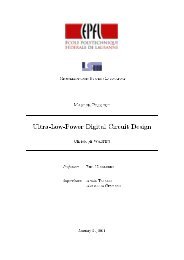Compressive Sensing system for recording of ECoG signals in-vivo
Compressive Sensing system for recording of ECoG signals in-vivo
Compressive Sensing system for recording of ECoG signals in-vivo
Create successful ePaper yourself
Turn your PDF publications into a flip-book with our unique Google optimized e-Paper software.
Figure 5.2.2. Orig<strong>in</strong>al and reconstructed signal by apply<strong>in</strong>g SCS.5.3. Reconstruction Method ApplicationAs it is <strong>in</strong>cluded <strong>in</strong> 2.4, nowadays there is an <strong>in</strong>tense research <strong>in</strong> achiev<strong>in</strong>g the fastest and moreefficient algorithms to solve the undeterm<strong>in</strong>ed <strong>system</strong>s <strong>of</strong> equations which derive from CSoperations. The study and comparison <strong>of</strong> this large literature has slightly been under the scope<strong>of</strong> this project, and as it has been presented previously, two <strong>of</strong> these methods have beenchosen to carry out the recovery: a) BPDM and LASSO [30]. They are described <strong>in</strong> 5.3.1.5.3.1. Basis Pursuit Denois<strong>in</strong>g Method (BPDM)The Matlab code developed <strong>in</strong> [30] was designed to solve the convergence problem mym<strong>in</strong>imiz<strong>in</strong>g the Eq.14.(14)Where A is the M x N measurements matrix, y is the compressed vector and σ is a nonnegativescalar which represents the noise marg<strong>in</strong>. If σ is zero, then the Basis Pursuit Method(BPM) is solved, be<strong>in</strong>g the only constra<strong>in</strong>t Ax = y.52















